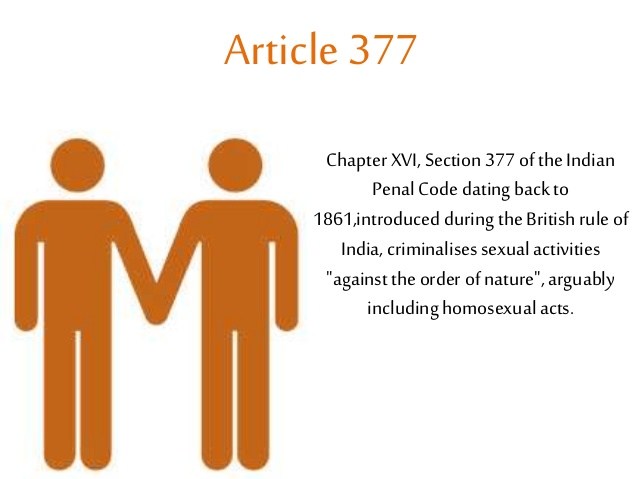Context:
The Supreme Court tore into its own judgment of 2014 upholding Section 377 of the Indian Penal Code, which criminalises consensual sexual acts of adults in private.
What is Section 377 of Indian Penal Code?
- Section 377 of the Indian Penal Code dating back to 1860, introduced during the British rule of India, criminalises sexual activities “against the order of nature”.
- It arguably includes the consensual homosexual sexual and transgender sexual activities, thus making them criminal offence.
- The punishment under this Section can be life imprisonment or imprisonment upto 10 years.

Earlier takes on Sec 377:
- In 2000 172nd Law Commission report recommended first time to decriminalize Section 377.
- Naz Foundation an NGO for HIV/AIDS and sexual health filed a PIL in 2001 against Section 377 in Delhi High Court which dismissed the petition.
- In May 2008, the case came up for hearing in the Delhi High Court, but the Government was undecided on its position, with The Ministry of Home Affairs maintaining a contradictory position to that of The Ministry of Health on the issue of enforcement of Section 377 with respect to homosexuality.
- In 2009, The Delhi High Court had held that Section 377 is in violation of Article 14, 15 and 21 of the Constitution in so far as it criminalises consensual sexual acts of adults in private. HC said that Section 377 to apply only to non-consensual, penile, non-vaginal sex, and sexual acts by adults with minors
- In 2013, the two judge Supreme Court Bench in the Suresh Kumar Koushal vs Naz Foundation case overturned the Delhi High Court order. SC said Section 377 is constitutional and applies to sexual acts irrespective of age or consent of the parties.
- A curative petition was filed by Naz Foundation and others in 2014.
What is the view of Parliamentary panel?
- A parliamentary panel- the standing committee on social justice and empowerment, has suggested that the Centre should exempt the transgender community from the ambit of the law criminalising homosexuality, noting that welfare of this socially marginalised group requires an initiative in this direction.
- Other recommendations: the panel has said that the Transgender Persons (Protection of Rights) Bill should recognise transgender persons’ right to marriage, partnership, divorce and adoption.
What does the latest verdict of SC say?
- The Supreme Court struck down the judgment of 2014 upholding Section 377 of the Indian Penal Code.
- The nine-judge Bench concluded that the 2014 verdict by a two-judge Bench pandered to a “majoritarian” view to turn down the LGBT (lesbian, gay, bisexual, and transgender) community their inherent fundamental rights of life, personal liberty, equality and gender discrimination.
- The bench held that fundamental rights are not subject to minority or majority.
- It also observed that the chilling effect of Section 377 “poses a grave danger to the unhindered fulfilment of one’s sexual orientation, as an element of privacy and dignity”.
- Finally the bench held that these rights are not illusory, but are real rights founded on sound constitutional doctrine.
Way forward
- Sexual orientation is an essential attribute of privacy. Discrimination against an individual on the basis of sexual orientation is deeply offensive to the dignity and self-worth of the individual,
- The argument against Section 377 should not only be based on the right to privacy but also to be premised on the idea of the right to equality before the law.
- The question of constitutionality of Section 377 is still pending consideration before a larger Bench, and it should be heard and decided in the appropriate proceedings.
- However, by making sexual orientation an essential attribute of right to privacy, the SC has moved a step closer in decriminalising transgender and homosexual sexual activities.
Source:
agriculture from economy ( optional paper ) point of view
Very well written article, with a proper background, present verdict and conclusion. Among other daily initiatives online, this looks like most user-friendly as we can directly use this as our answer. Thanks guys!